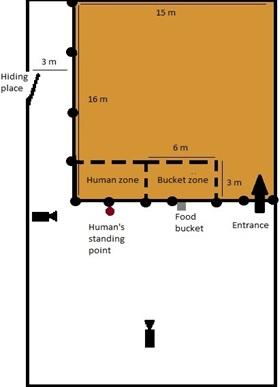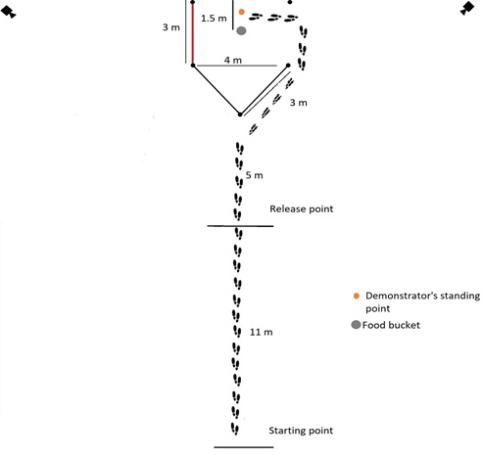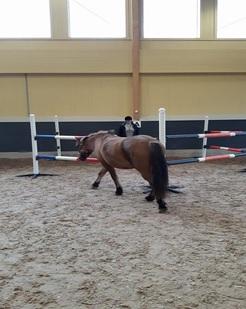Animals
This study was conducted at Smedstad ridsportcenter in Linköping, Sweden from August 2017 – October 2017. 22 riding school horses participated in this study. The group of horses were on beforehand ranked as low-, middle- or high according to the riding school manager in order to ensure that the study included approximately the same number of subordinate and dominant individuals. All participants were also grouped based on size (horse/pony), sex (mare/gelding) and age (young/old). The age groups were composed of the eleven youngest versus the eleven oldest individuals.
Experiment 1-Unsolvable task

Experiment 1 was supposed to investigate whether or not horses sekhuman contavt when faced with an unsolvable task. A food bucket was hanging on the fence and was covered with a lid of plexiglass in order to prevent the horses from reaching the content during trials. The horses' behaviour towards an unfamilliar human was analysed for one minute before three pieces of carrot was put into the bucket. Thereafter, the horses' behaviour was analysed again. In addition to this was two controls also performed in order to evaluate if the presence of a human or food alone at the testing area had an effect on the horse’ behaviour.
Experiment 2-Detour
Control test

The test started with one of the sides of the set up open. The demonstrator started off in the middle of the detour set-up and dropped three pieces of carrot into the bucket whilde the horse was watching from the starting point 15 meters away. Thereafter the demonstrator called for the horse to come. The helper led the horse towards the detour set-up and let it lose 5 m away from the detour set-up. The horse had thereafter one minute to solve the task. This control was repeated after the demonstration test as a second control.
Demonstration test

In the demonstration test opposite side of the detour set-up was opened. The demonstrator, the helper, and the observing horse all started at the starting point. The demonstrator gave the horse one piece of carrot and walked back and forth between the horse and the bucket three times. When the last demonstration was finished the demonstrator stayed within the detour set-up. Thereafter, the helper led the horse towards the detour set-up and released the horse five meters from the detour set-up All horses had a maximum of three chances in order to solve the detour task and could thereby observe in total nine demonstrations. However, if a horse succeeded (at least one front leg through the opening in the fence) no more demonstration tests followed.
Personality survey
A horse personality questionnaire, consisting of 25 behaviour defined adjectives was completed by the staff. Scores on these adjectives thereafter gave scores n six different personality traits, Dominance, Anxiousness, Excitability, Protection, Sociability and Inquisitiveness. These scores were used to investigate if horses with different personality traits differed in their behaviour in the two experiments.
In addition, the staff was also asked to rank each horse on a seven pint scale in order to see if this rating correlated with the previous one in which horses were divided into three groups, low, middle, and high. Score 1-4 thereafter formed a low ranked group while score 5-7 formed a high ranked group.
Responsible for this page:
Director of undergraduate studies Biology
Last updated:
05/10/18
